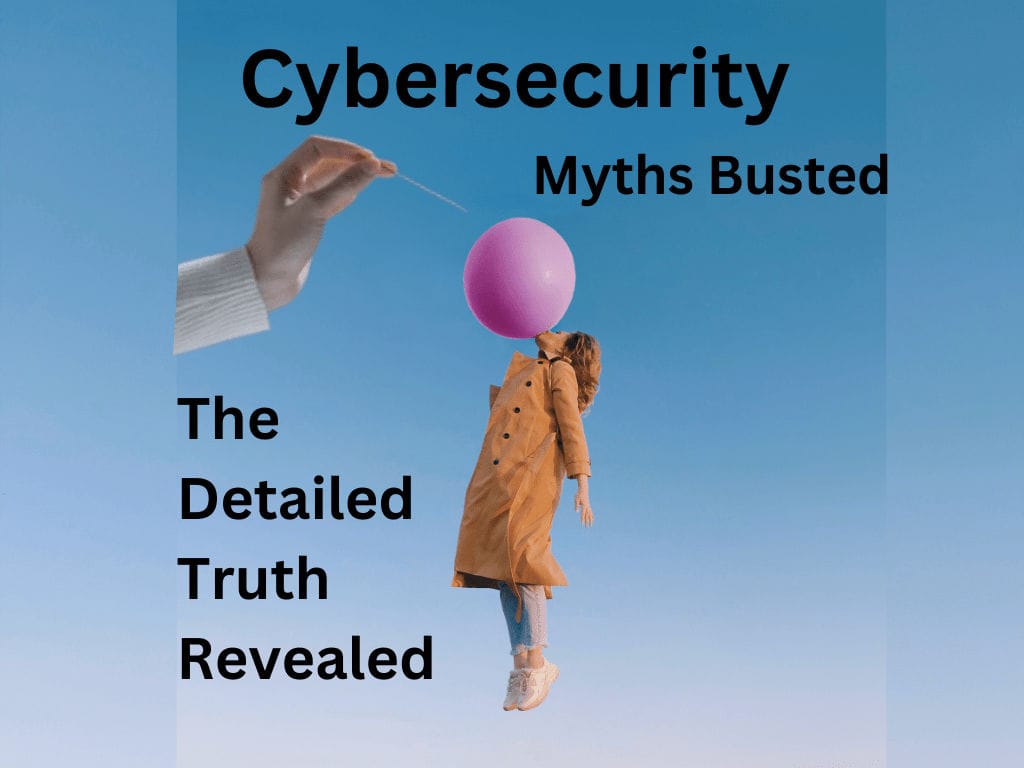Cybersecurity is one of the most important and challenging topics in the digital age. As we rely more and more on technology for our personal and professional lives, we also face more and more threats from cybercriminals who want to exploit our data, devices, and systems.
As discussed in a previous post cyberattacks can have serious consequences for individuals and businesses, such as identity theft, financial loss, reputational damage, operational disruption, legal liability, and even physical harm.
However, despite the importance and complexity, there are many myths and misconceptions that people have about cybersecurity. These myths and misconceptions can affect our security posture and behavior, and make us more vulnerable to cyberattacks.
In this blog post, we will debunk 18 common cybersecurity myths and some of the misconceptions that people have. We will also provide some facts and tips to help you improve your cybersecurity awareness and hygiene.

Table of Contents
Myth 1: Antivirus software is enough to protect your devices and data
Many people think that antivirus software is enough to protect their devices and data from malware and other threats. They believe that antivirus software can detect and block all malicious programs and activities, and keep their devices and data safe.
However, this is a myth. Antivirus software is not a silver bullet that can protect your devices and data from all threats. Antivirus software has some limitations, such as:
- It needs to be updated regularly to keep up with the latest threats
- It can be bypassed or disabled by some advanced malware
- It can have false positives or negatives, meaning it can miss some threats or flag some legitimate programs as threats
- It can slow down your device performance or cause compatibility issues with other programs
- It can only protect your device from malware, but not from other threats such as phishing, ransomware, DDoS, etc.
Tips 1
Therefore, antivirus software is not enough to protect your devices and data. You need to complement it with other security measures, such as:
- Using a firewall to filter incoming and outgoing network traffic
- Using a VPN to encrypt your data in transit
- Using encryption to protect your data at rest
- Using backups to restore your data in case of loss or damage
- Using multifactor authentication (MFA) to verify your identity before accessing your accounts or systems
- Using strong passwords to secure your accounts or systems
- Using a password manager to store and generate passwords securely
Myth 2: Passwords are secure and hard to crack
Many people think that passwords are secure and hard to crack if they are long or complex. They believe that passwords can protect their accounts or systems from being hacked by cybercriminals.
However, this is a myth. Passwords are not secure and hard to crack if they are weak or reused. Passwords can be easily guessed or stolen by cybercriminals using various methods, such as:
- Brute force attacks: Trying different combinations of characters until finding the right password
- Dictionary attacks: Trying common words or phrases that are likely to be used as passwords
- Social engineering attacks: Tricking or persuading users to reveal their passwords
- Phishing attacks: Sending fake emails or websites that ask users to enter their passwords
- Keylogging attacks: Installing malware that records users’ keystrokes
- Credential stuffing attacks: Using stolen passwords from one site to access other sites
Tips 2
Therefore, passwords are not secure and hard to crack if they are weak or reused. But you can’t do without them. You need to make strong, unique passwords, and change them frequently. You should also use a password manager to store and generate passwords securely. Here are some tips for creating strong passwords:
- Use at least 12 characters
- Use a mix of uppercase and lowercase letters, numbers, and symbols
- Use different passwords for different accounts or systems
- Use random words or phrases that are easy to remember but hard to guess
- Use acronyms or mnemonics to help you remember your passwords
- Avoid using personal information such as names, dates, places, etc.
- Avoid using common words or phrases such as password, 123456, qwerty, etc.
Myth 3: Public Wi-Fi is safe and encrypted
Many people think that public Wi-Fi is safe and encrypted if it has a password or a lock icon. They believe that public Wi-Fi can protect their data from hackers and malware, and allow them to access the internet securely.
However, this is a myth. Public Wi-Fi is not safe and encrypted if it is unsecured or malicious. Public Wi-Fi can expose your data to hackers and malware using various methods, such as:
- Man-in-the-middle attacks: Intercepting or altering your data in transit
- Rogue access points: Setting up fake Wi-Fi networks that look legitimate but are controlled by hackers
- Packet sniffing: Capturing and analyzing your data packets
- Evil twin attacks: Creating a duplicate of a legitimate Wi-Fi network with the same name but different settings
- Malware injection: Infecting your device with malware through malicious downloads or links
Tips 3
Public Wi-Fi is not safe and encrypted. How can you be sure if it is secure or malicious? So, you should avoid it or use it with caution if absolutely necessary. You should also use a VPN to encrypt your data in transit, and disable automatic Wi-Fi connection on your devices. Here are some tips for using public Wi-Fi safely:
- Verify the name and password of the Wi-Fi network before connecting
- Use HTTPS websites or apps that have SSL encryption
- Avoid accessing sensitive or personal information such as banking, email, social media, etc.
- Turn off file sharing and Bluetooth on your devices
- Use antivirus software and firewall on your devices
- Log out of your accounts and websites when you are done
Myth 4: Cyberattacks only target large organizations and governments
Many people think that cyberattacks only target large organizations and governments that have valuable or sensitive data, or political or economic influence. They believe that cyberattacks do not affect individuals or small businesses that have nothing to offer or lose.
However, this is a myth. Cyberattacks can target anyone regardless of size or sector, and can have various motives and impacts. Cyberattacks can affect individuals or small businesses in different ways, such as:
- Identity theft: Stealing personal information such as name, address, date of birth, social security number, etc. to commit fraud or crimes
- Financial loss: Stealing money or credit card information to make unauthorized purchases or transactions
- Reputational damage: Defacing websites or social media accounts to spread false or malicious information
- Operational disruption: Damaging or deleting data or systems to cause downtime or loss of productivity
- Legal liability: Breaching data protection laws or regulations to expose customer or employee data
- Physical harm: Hacking into smart devices or systems to cause physical damage or injury
Tips 4
Since, cyberattacks can target anyone regardless of size or sector, and can have various motives and impacts. You should also be aware of the common types of cyberattacks, such as phishing, ransomware, DDoS, etc., and how to prevent or respond to them. Here are some tips for protecting yourself or your business from cyberattacks:
- Update your software and devices regularly with the latest patches and updates
- Backup your data regularly to a secure location
- Use strong passwords and MFA for your accounts and systems
- Use encryption for your data at rest and in transit
Myth 5: Cybersecurity is expensive and complicated
Many people think that cybersecurity is expensive and complicated, and requires a lot of resources and expertise to implement and maintain. They believe that cybersecurity is beyond their reach or budget, and that they need to hire professionals or buy expensive products or services to secure their devices and data.
However, this is a myth. Cybersecurity can be affordable and simple, and there are many resources and tools available to help you improve your security posture.
Tips 5
Cybersecurity does not have to be costly or complex, and you can do a lot to protect yourself or your business from cyberattacks with minimal investment or effort. Here are some tips for making cybersecurity affordable and simple:
- Use free or low-cost security tools and services that are available online, such as antivirus software, VPNs, encryption tools, password managers, etc.
- Use open-source or cloud-based security solutions that are reliable and scalable, such as firewalls, backups, MFA, etc.
- Use online courses or tutorials to learn more about cybersecurity and how to implement it effectively, such as Free Cyber Security Courses with Certification, Free and Affordable Email Security Solutions, Common Cybersecurity Threats for Small Businesses, etc.
- Use online platforms or communities to get support or advice from other cybersecurity experts or enthusiasts, such as forums, blogs, podcasts, webinars, etc.
- Use online tools or services to test or audit your security level or performance, such as vulnerability scanners, penetration testers, security checklists, etc.
Myth 6: Cybersecurity is the sole responsibility of IT professionals
Many people think that cybersecurity is the sole responsibility of IT professionals who have the skills and knowledge to handle all aspects of cybersecurity and respond to all incidents. They believe that cybersecurity is not their concern or duty, and that they can rely on IT professionals to take care of it.cybersecurity
However, this is a myth. Cybersecurity is a shared responsibility of everyone in the organization, and requires awareness, education, and training. Cybersecurity is not only a technical issue, but also a human and behavioral issue.
Tips 6
Everyone can be a potential target or source of a breach, and everyone can contribute to the security or insecurity of the organization. Here are some tips for making cybersecurity a shared responsibility:
- Follow the security policies and procedures that are established by the organization
- Attend the security awareness training sessions that are provided by the organization
- Report any suspicious or unusual activities or incidents that you encounter or witness
- Avoid clicking on links or attachments from unknown or untrusted sources
- Avoid sharing your passwords or credentials with anyone
- Avoid using personal devices or accounts for work purposes
- Avoid downloading or installing unauthorized software or applications
Myth 7: Cybersecurity is a one-time activity and does not require continuous monitoring and updating
Many of us may think that cybersecurity is a one-time activity and does not require continuous monitoring and updating. We may believe that once we have implemented some security measures or solutions, all’s done with cybersecurity and we do not need to worry about it anymore.
However, this is a myth. Cybersecurity is an ongoing process that needs to adapt to the changing threat landscape and technologies. Cybersecurity is not a static or fixed state, but a dynamic and evolving one.
Tips 7
You need to monitor and update your security measures or solutions regularly to keep up with the latest cyber threats and trends, and to ensure that they are effective and efficient. You also need to align your security measures or solutions with your business goals and objectives, and to ensure that they are relevant and appropriate. Here are some tips for making cybersecurity an ongoing process:
- Update your software and devices regularly with the latest patches and updates
- Update your passwords regularly with strong and unique ones
- Update your backups regularly with the latest data
- Update your security tools and services regularly with the latest features and functions
- Update your security knowledge and skills regularly with the latest information and training
- Review your security needs and risks regularly based on your industry, size, and goals
- Review your security measures or solutions regularly based on their performance and feedback
- Review your security policies and procedures regularly based on the changes and improvements
- Align your security measures or solutions with your business goals and objectives
- Align your security policies and procedures with the relevant laws and regulations
Myth 8: Cybersecurity is only for big businesses
Many people think that cybersecurity is only for big businesses that have valuable or sensitive data, or large networks or systems. They believe that cybersecurity is not relevant or necessary for small businesses that have nothing to offer or lose.
However, this is a not true. Cybersecurity is also for small businesses that are equally or even more vulnerable to cyberattacks than big businesses. Cybersecurity is relevant and necessary for small businesses for various reasons, such as:
- Small businesses have valuable or sensitive data, such as customer or employee information, financial records, intellectual property, etc.
- Small businesses have limited resources and expertise to implement and maintain cybersecurity measures or solutions
- Small businesses have less awareness and training on cybersecurity best practices and risks
- Small businesses are often targeted by cybercriminals because they are easier to breach or exploit, or because they can be used as a gateway to larger organizations
- Small businesses can suffer more from the consequences of cyberattacks, such as data loss or damage, reputational damage, operational disruption, legal liability, etc.
Tips 8
Cybersecurity is also for small businesses that are equally or even more vulnerable to cyberattacks than big businesses. You should also take cybersecurity seriously and invest in it accordingly. Here are some tips for improving your cybersecurity as a small business:
- Assess your security needs and risks based on your industry, size, and goals
- Choose the security measures or solutions that suit your needs and budget
- Implement the security measures or solutions effectively and efficiently
- Monitor and update the security measures or solutions regularly
- Educate and train your employees and customers on cybersecurity awareness and behavior
Myth 9: Cybersecurity is only a technical issue
Many people think that cybersecurity is only a technical issue that involves technology, such as software, hardware, networks, systems, devices, etc. They believe that cybersecurity is only about using technology to protect technology from cyberattacks.
Now, that is a myth. Cybersecurity is a human and organizational issue that involves people, processes, and culture. Cybersecurity is not only about using technology to protect technology from cyberattacks, but also about using people to protect people from cyberattacks. Here are some examples of how people can affect cybersecurity:
- People can be the targets of cyberattacks, such as phishing, social engineering, identity theft, etc.
- People can be the sources of cyberattacks, such as insiders, hackers, competitors, etc.
- People can be the enablers of cyberattacks, such as employees, customers, partners, etc.
- People can be the defenders of cyberattacks, such as IT professionals, security experts, managers, etc.
Tips 9
You should also consider the human and organizational factors that influence cybersecurity and how to address them. Here are some tips for making cybersecurity a human and organizational issue:
- Establish a security policy and procedure that defines the roles and responsibilities of everyone in the organization
- Create a security culture and awareness that fosters trust and collaboration among everyone in the organization
- Provide security education and training that enhances the skills and knowledge of everyone in the organization
- Encourage security feedback and communication that improves the performance and satisfaction of everyone in the organization
Myth 10: Cybersecurity is only about protecting data
Many people think that cybersecurity is only about protecting data from unauthorized access or use by cybercriminals. They believe that cybersecurity is only about ensuring the confidentiality, integrity, and availability of data.
This is a myth. Cybersecurity is also about protecting other aspects of the business from cyberattacks. Cybersecurity is not only about ensuring the confidentiality, integrity, and availability of data but also about ensuring the reputation, trust, and continuity of the business. Here are some examples of how cyberattacks can affect other aspects of the business:
- Reputation: Cyberattacks can damage the reputation of the business by exposing its weaknesses or failures, spreading false or malicious information, or causing customer dissatisfaction or complaints
- Trust: Cyberattacks can erode the trust of the business by violating its promises or expectations, breaching its contracts or agreements, or compromising its ethics or values
- Continuity: Cyberattacks can disrupt the continuity of the business by causing downtime or loss of productivity, destroying or deleting data or systems, or demanding ransom or extortion
Tips 10
You should also care about how cyberattacks can affect your reputation, trust, and continuity as a business owner or manager. Here are some tips for protecting your reputation, trust, and continuity from cyberattacks:
- Implement security measures or solutions that prevent, detect, and respond to cyberattacks effectively and efficiently
- Communicate with your customers and stakeholders transparently and honestly about your security status and incidents
- Recover from cyberattacks quickly and smoothly with a robust incident response plan
Myth 11: Cybersecurity is only about preventing attacks
Many people think that cybersecurity is only about preventing attacks from happening in the first place. They believe that cybersecurity is only about implementing security measures or solutions that can stop or block cybercriminals from accessing or using their devices and data.
However, this is a myth. Cybersecurity is also about detecting, responding, and recovering from attacks that have already happened or are happening. Cybersecurity is not only about implementing security measures or solutions that can stop or block cybercriminals from accessing or using their devices and data, but also about using security tools or services that can alert or inform them of any suspicious or unusual activities or incidents, and help them to take appropriate actions or steps to mitigate or resolve them. Here are some examples of how detecting, responding, and recovering from attacks can help cybersecurity:
- Detecting: Detecting attacks can help cybersecurity by:
- Alerting users or administrators of any potential or ongoing threats or breaches
- Identifying the source, type, and scope of the attacks
- Analyzing the impact and severity of the attacks
- Providing evidence and information for investigation and prosecution
- Responding: Responding to attacks can help cybersecurity by:
- Containing or isolating the affected devices or systems
- Eradicating or removing the malicious programs or activities
- Restoring or repairing the damaged or corrupted data or systems
- Reporting or notifying the relevant authorities or parties
- Recovering: Recovering from attacks can help cybersecurity by:
- Evaluating or assessing the lessons learned and best practices from the attacks
- Improving or enhancing the security measures or solutions based on the feedback and recommendations
- Updating or revising the security policies and procedures based on the changes and improvements
- Testing or verifying the security level or performance based on the new standards and expectations
Tips 11
Cybersecurity is about detecting, responding, and recovering from attacks that have already happened or are happening. You should also have a robust incident response plan in place that can guide you through the process of detecting, responding, and recovering from attacks. Here are some tips for creating an incident response plan:
- Define the roles and responsibilities of the incident response team members
- Establish the communication channels and protocols for the incident response team members
- Develop the procedures and steps for each phase of the incident response process
- Document the tools and resources that are needed for each phase of the incident response process
- Train and test the incident response team members on their skills and knowledge
Myth 12: Cybersecurity is a one-time thing
Many people think that cybersecurity is a one-time thing that can be done once and for all. They believe that cybersecurity is a static or fixed state that can be achieved or maintained with minimal effort or change.
However, this is a myth. Cybersecurity is an ongoing process that needs to be updated and reviewed regularly, and aligned with the business goals and objectives. Cybersecurity is a dynamic and evolving state that can change or improve with constant effort or change. You need to update and review your security measures or solutions regularly to keep up with the latest threats and trends, and to ensure that they are effective and efficient. You also need to align your security measures or solutions with your business goals and objectives, and to ensure that they are relevant and appropriate.
Tips 12
Here are some tips for making cybersecurity an ongoing process:
- Update your software and devices regularly with the latest patches and updates
- Update your passwords regularly with strong and unique ones
- Update your backups regularly with the latest data
- Update your security tools and services regularly with the latest features and functions
- Update your security knowledge and skills regularly with the latest information and training
- Review your security needs and risks regularly based on your industry, size, and goals
- Review your security measures or solutions regularly based on their performance and feedback
- Review your security policies and procedures regularly based on the changes and improvements
- Align your security measures or solutions with your business goals and objectives
- Align your security policies and procedures with the relevant laws and regulations
Myth 13: Cybersecurity is a one-size-fits-all solution
Many people think that cybersecurity is a one-size-fits-all solution that can be applied universally to any device, system, or situation. They believe that cybersecurity is a standard or generic solution that can suit any need or challenge.
However, this is a myth. Cybersecurity is a customized and tailored solution that can be adapted specifically to each device, system, or situation. Cybersecurity is a unique or specific solution that can meet any need or challenge. You need to customize and tailor your security measures or solutions based on the specific needs and challenges of each device, system, or situation. You also need to take into account the industry, size, and goals of your business, and the type, scope, and impact of the threats that you face.
Tips 13
Here are some tips for making cybersecurity a customized and tailored solution:
- Assess your security needs and risks based on your industry, size, and goals
- Assess your security threats based on their type, scope, and impact
- Choose the security measures or solutions that suit your needs and risks
- Choose the security tools or services that suit your threats
- Implement the security measures or solutions effectively and efficiently
- Implement the security tools or services reliably and securely
- Monitor and update the security measures or solutions regularly
- Monitor and update the security tools or services regularly
Myth 14: Cybersecurity is a set-it-and-forget-it solution
Many people think that cybersecurity is a set-it-and-forget-it solution that can be installed or activated once and then left alone. They believe that cybersecurity is a self-sufficient or autonomous solution that can work without any intervention or maintenance.
However, this is a myth. Cybersecurity is a monitor-and-maintain solution that needs to be checked or adjusted periodically. Cybersecurity is a dependent or interactive solution that needs to work with human intervention or maintenance. You need to monitor and maintain your security measures or solutions periodically to ensure that they are working properly and optimally. You also need to check or adjust them according to the changing threat landscape and technologies, and to fix any issues or problems that may arise.
Tips 14
Here are some tips for making cybersecurity a monitor-and-maintain solution:
- Monitor your devices and systems regularly for any signs of compromise or malfunction
- Monitor your data regularly for any signs of loss or damage
- Monitor your network traffic regularly for any signs of intrusion or anomaly
- Maintain your devices and systems regularly by applying patches, updates, fixes, etc.
- Maintain your data regularly by backing up, encrypting, deleting, etc.
- Maintain your network traffic regularly by filtering, blocking, redirecting, etc.
Myth 15: Cybersecurity is only about technology
Many people think that cybersecurity is only about technology, such as software, hardware, networks, systems, devices, etc. They believe that cybersecurity is only about using technology to protect technology from cyberattacks.
However, this is a myth. Cybersecurity is also about policies, procedures, and practices that govern the security of the business. Cybersecurity is not only about using technology to protect technology from cyberattacks, but also about using policies, procedures, and practices to protect the business from cyberattacks. Here are some examples of how policies, procedures, and practices can affect cybersecurity:
- Policies: Policies are the rules or guidelines that define the roles, responsibilities, and expectations of everyone in the organization regarding cybersecurity. Policies can help cybersecurity by:
- Establishing the security goals and objectives of the organization
- Establishing the security standards and requirements of the organization
- Establishing the security roles and responsibilities of everyone in the organization
- Establishing the security communication and reporting channels of the organization
- Procedures: Procedures are the steps or actions that implement the policies in a consistent and effective way. Procedures can help cybersecurity by:
- Providing the security instructions and directions for everyone in the organization
- Providing the security checklists and templates for everyone in the organization
- Providing the security tools and resources for everyone in the organization
- Providing the security feedback and evaluation for everyone in the organization
- Practices: Practices are the habits or behaviors that reflect the policies and procedures in a practical and realistic way. Practices can help cybersecurity by:
- Demonstrating the security awareness and culture of everyone in the organization
- Demonstrating the security skills and knowledge of everyone in the organization
- Demonstrating the security performance and satisfaction of everyone in the organization
- Demonstrating the security improvement and innovation of everyone in the organization
Tips 15
You should also consider the policies, procedures, and practices that influence cybersecurity and how to implement them effectively. Here are some tips for making cybersecurity a policy, procedure, and practice issue:
- Develop a security policy that defines the roles, responsibilities, and expectations of everyone in the organization regarding cybersecurity
- Develop a security procedure that provides the steps or actions for implementing the security policy in a consistent and effective way
- Develop a security practice that reflects the security policy and procedure in a practical and realistic way
- Review and update your security policy, procedure, and practice regularly based on the changes and improvements
Myth 16: We don’t have anything valuable for hackers to steal is a cybersecurity myth
Many people think that they don’t have anything valuable for hackers to steal, such as financial or personal data, or intellectual property. They believe that hackers are only interested in these types of data, and that they have nothing to offer or lose.
However, this is a myth. Everyone has something valuable for hackers to steal, regardless of what type of data they have. Hackers are not only interested in financial or personal data, or intellectual property, but also in other types of data, such as:
- Behavioral data: Data that reflects your online habits or preferences, such as browsing history, search queries, social media posts, etc.
- Location data: Data that reveals your physical whereabouts or movements, such as GPS coordinates, Wi-Fi networks, Bluetooth devices, etc.
- Biometric data: Data that identifies your physical characteristics or features, such as fingerprints, facial recognition, voice recognition, etc.
- Health data: Data that relates to your physical or mental health or well-being, such as medical records, prescriptions, fitness trackers, etc.
- Environmental data: Data that relates to your surroundings or conditions, such as temperature, humidity, light, sound, etc.
These types of data can be valuable for hackers for various reasons, such as:
- Profiling: Creating a detailed profile of you based on your online habits or preferences, physical whereabouts or movements, physical characteristics or features, physical or mental health or well-being, or surroundings or conditions
- Targeting: Targeting you with personalized ads, offers, or messages based on your online habits or preferences, physical whereabouts or movements, physical characteristics or features, physical or mental health or well-being, or surroundings or conditions
- Extorting: Extorting you with threats, demands, or blackmail based on your online habits or preferences, physical whereabouts or movements, physical characteristics or features, physical or mental health or well-being, or surroundings or conditions
Tips 16
Everyone has something valuable for hackers to steal, regardless of what type of data they have. You should also care about how hackers can use your data for malicious purposes and how to protect it. Here are some tips for protecting your data from hackers:
- Use encryption to protect your data at rest and in transit
- Use VPNs to protect your data in transit
- Use MFA to protect your accounts and systems
- Use antivirus software and firewall to protect your devices and systems
- Use privacy settings to control who can access your data
Myth 17: Cyberattacks are easy to detect and prevent
Many people think that cyberattacks are easy to detect and prevent. They believe that cyberattacks are obvious or noticeable, and that they can be stopped or blocked by simple or basic security measures or solutions.
However, this is a myth. Cyberattacks can be stealthy and sophisticated, and require constant monitoring and analysis to detect and respond to them. Cyber attacks can use various techniques and methods to evade or bypass security measures or solutions, such as:
- Encryption: Encrypting the data or communication to avoid detection or interception
- Obfuscation: Hiding or disguising the code or activity to avoid analysis or identification
- Polymorphism: Changing or mutating the code or activity to avoid signature-based detection
- Zero-day exploits: Exploiting unknown or unpatched vulnerabilities to avoid prevention or protection
- Social engineering: Manipulating or persuading users to perform actions or reveal information that can compromise their security
Tips 17
You should also use advanced or specialized security tools or services that can help you detect and respond to cyberattacks, such as:
- Intrusion detection systems (IDS): Systems that monitor network traffic for any signs of intrusion or anomaly
- Intrusion prevention systems (IPS): Systems that block or prevent network traffic that is identified as malicious or suspicious
- Security information and event management (SIEM): Systems that collect, correlate, and analyze security data from various sources and provide alerts or reports
- Endpoint detection and response (EDR): Systems that monitor, detect, and respond to threats on endpoints such as devices or systems
- Threat intelligence: Services that provide information and insights on current or emerging threats and how to counter them
Myth 18: We are secure because we use firewalls, encryption, and backups
Many people think that they are secure because they use firewalls, encryption, and backups. They believe that these security measures or solutions can protect their network and data from any external or internal threats, and that they don’t need any other security measures or solutions.
However, this is a myth. Firewalls, encryption, and backups are not enough to protect your network and data from all threats. These security measures or solutions have some limitations, such as:
- Firewalls can only filter incoming and outgoing network traffic based on predefined rules or criteria. They can be bypassed or disabled by some advanced threats such as malware, DDoS, etc. They can have false positives or negatives, meaning they can miss some threats or block some legitimate traffic. They can slow down your network performance or cause compatibility issues with other applications.
- Encryption can only protect your data at rest and in transit, but not in use. It can be decrypted or cracked by some advanced threats such as quantum computing, brute force attacks, etc. It can have vulnerabilities or flaws that can expose your data. It can cause performance issues or compatibility issues with other applications.
- Backups can only protect your data from loss or damage by any cause. They can be corrupted or deleted by some threats such as ransomware, malware, etc. They can be stolen or accessed by some threats such as hackers, insiders, etc. They can be outdated or incomplete if they are not updated regularly. They can cause storage issues or cost issues if they are not managed properly.
Tips 18
Firewalls, encryption, and backups are not enough to protect your network and data from all threats. You need to complement them with other security measures or solutions, such as:
- Using antivirus software to protect your devices from malware
- Using VPNs to encrypt your data in transit
- Using MFA to verify your identity before accessing your network or data
- Using strong passwords to secure your network or data
- Using security tools or services that can help you detect and respond to cyberattacks, such as IDS, IPS, SIEM, EDR, threat intelligence, etc.
Conclusion
Cybersecurity is one of the most important and challenging topics in this digital age. However, there are many myths and misconceptions that people have about it. These myths and misconceptions can affect our security posture and behavior, and make us more vulnerable to cyberattacks.
In this blog post, we have debunked some of the most common cybersecurity myths and misconceptions that people have, and provided some facts and tips to help you improve your cybersecurity awareness and hygiene. We hope that this blog post has helped you to understand cybersecurity better and to protect yourself or your business from cyberattacks.
If you want to learn more about cybersecurity check out our post on Free Cybersecurity Courses.Thank you for reading. 😊





I like the efforts you have put in this, regards for all the great content.
Thank you Mail Tm.
I have been browsing online more than three hours today yet I never found any interesting article like yours It is pretty worth enough for me In my view if all website owners and bloggers made good content as you did the internet will be a lot more useful than ever before
Wonderful web site Lots of useful info here Im sending it to a few friends ans additionally sharing in delicious And obviously thanks to your effort